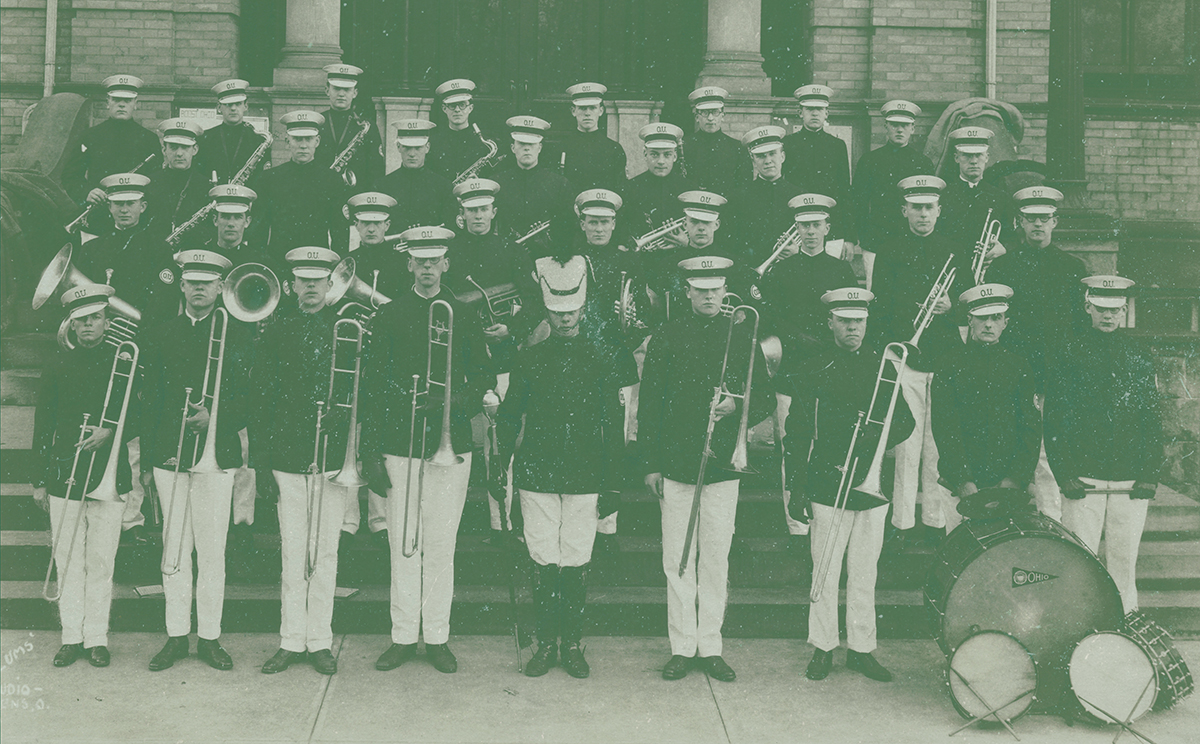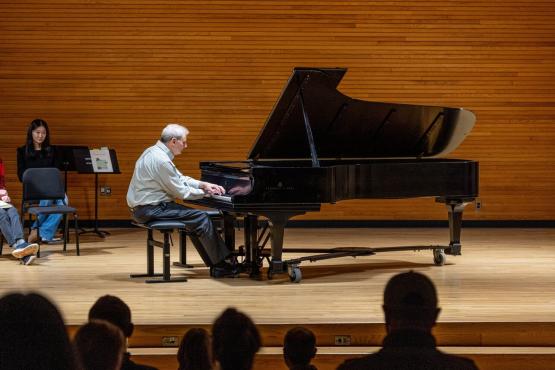

“Ladieeeees aaaand gentlemennnn, under the direction of Dr. Richard Suk, we proudly present the most exciting baaaand in the laaaand: the Ohio University Marching 110!”
The crowd starts to cheer. It almost feels like you’re climbing the first, steep hill of a roller coaster with nearly 200 of your closest friends, people who have become more like family. You’ve all put in the time and the sweat to prepare for this moment, but that doesn’t make it any less nerve-wracking—or any less thrilling.
You’re carrying on traditions more than five decades old: the white and black uniform with a green-outlined “OHIO” emblazoned diagonally across the front; the crisp steps, thighs parallel to the ground and calves extended 45 degrees; the triumphant, John Higgins-arranged fanfare, “Stand Up and Cheer.”
You’re connected to a history of excellence that extends back even further. It’s a thread that links current students to the first band members to wear those uniforms in 1967, to the beginning of the style of band that thrills audiences today. And in a more circuitous way, that thread connects to Homer T. Baird, GEN ’26, who started the first marching band at Ohio University in 1923.
“We pay homage to our past,” says Dr. Richard Suk. “There’s a small number of bands that have kept their uniforms that they used 50 years ago.”
“The band being so steeped in tradition in so many different ways is what makes it a special organization,” adds Josh Boyer, BMUS ’08, MM ’14, a former assistant band director and the field commander in 2007.
This year, Ohio University celebrates its 100-year history of marching bands and the traditions that have shaped The Most Exciting Band in the Land.
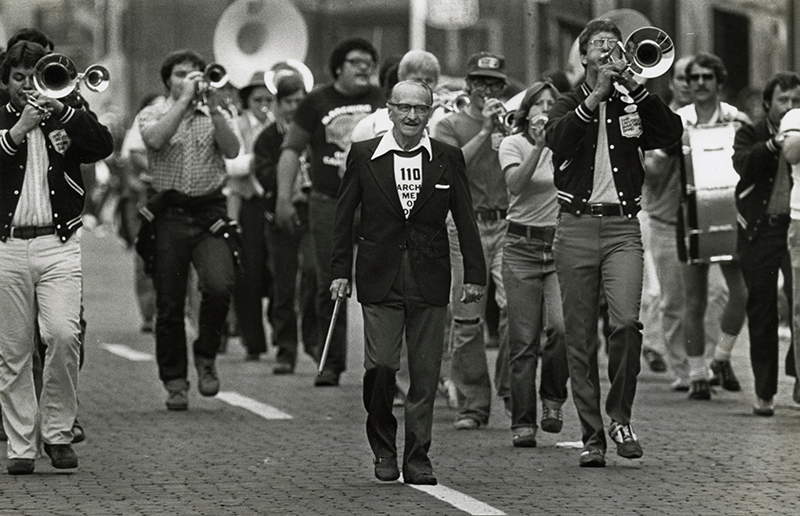
OHIO marching band founder Homer Baird leads the Alumni Band in the 1979 Homecoming Parade. Photo courtesy of the Mahn Center for Archives & Special Collections

The Origins
Homer Thomas Baird, of Nelsonville, started the first official marching band at Ohio University in 1923 with just over 40 members. Then-University President Dr. Elmer Bryan approved the new band under two conditions: the School of Music signed off and it cost the University no money.
Of that early band, Baird once said, “Twenty-five were top-notch musicians, and the others were coming along fine.”
Raymond Wyatt Connett, BSED ’31, directed that band from 1923 to 1925. The director of the School of Music, Dr. C.C. Robinson, gave his blessing to the new band and offered Connett a small sum of $10 per rehearsal, according to “Diamond Ohio: A History of the Ohio University Bands” by George Brozak, BMUS ’90, MMUS ’92, a former marching band member, graduate assistant and arranger.
The first uniforms were navy blue and white with long jackets and capes, though the band’s look would change multiple times over the years. (See our illustration of past uniforms below.)
Both football and marching band were put on hold for two years during World War II. Strapped for musicians during that time, OHIO’s concert band included women for the first time in January 1943; when the marching band stepped back onto the field in 1945, women joined them (though female-only bands had been formed under directors Curtis Janssen, 1929-1945, and Charles Gilbert, 1948-1950).
By the 1940s, Ohio University had a marching band, varsity band, symphonic band and three pep bands. Six directors would oversee the marching band before its most transformational one took the baton: Gene “Coach” Thrailkill, MED ’62.
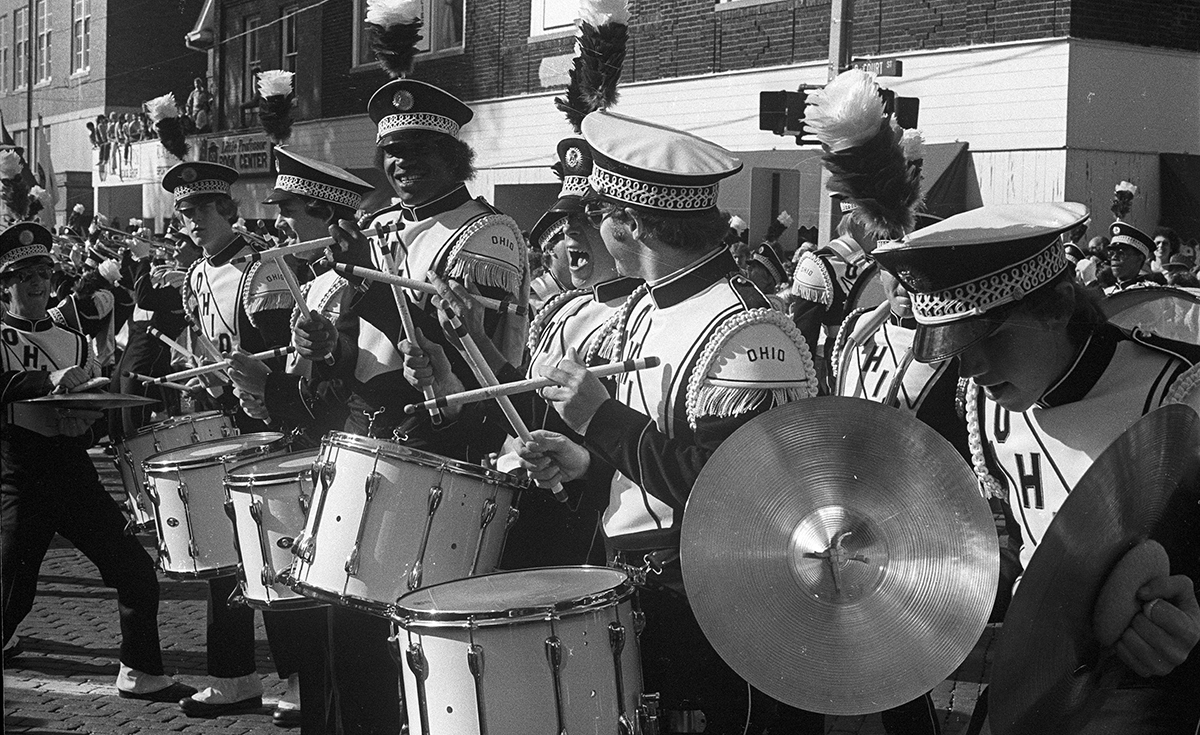
The band’s best-known drum cadence is “Funk,” which is played during parades and as the band leaves Peden Stadium. It features turns and high kicks. Alumni band members are told “you’re never too old to funk.” Photo courtesy of the Mahn Center for Archives & Special Collections.

The Transformations
Thrailkill, of Illinois, had a clear vision for the marching band when he took the reins from director Charles Minelli in 1967: new uniforms, new songs featuring the day’s top hits, a new marching technique—and no women.
“What I wanted to do, No. 1, was make the band enjoyable for the band members, and No. 2, I wanted to appeal to the student body,” Thrailkill said of the controversial decision in a 2013 WOUB documentary. Thrailkill died in 2021.
Thrailkill modeled the new “100 Marching Men of Ohio” (renamed the following year as the “110 Marching Men of Ohio”) off his alma mater, the University of Michigan’s Marching Men of Michigan. The Post was critical of the change, and several students bemoaned the loss of the majorettes.
“[Thrailkill] had a vision,” says David Fowler, BMUS ’72, a feature twirler in 1967 and the band’s final drum major from 1968 to 1970. “He knew what he wanted to see if he was sitting in the stands and what he wanted to hear: that wall of sound.”
The future of Thrailkill’s experiment would hang on the first note of the newly arranged “Stand Up and Cheer.”
“[When] we went out there for that first show in 1967, we were scared to death,” Fowler says. “But we had the new uniforms and all that, the new style and everybody up in the stands was like, ‘Woo, what is this?’ By the time we finished, we got a standing ovation, and the rest is history.”
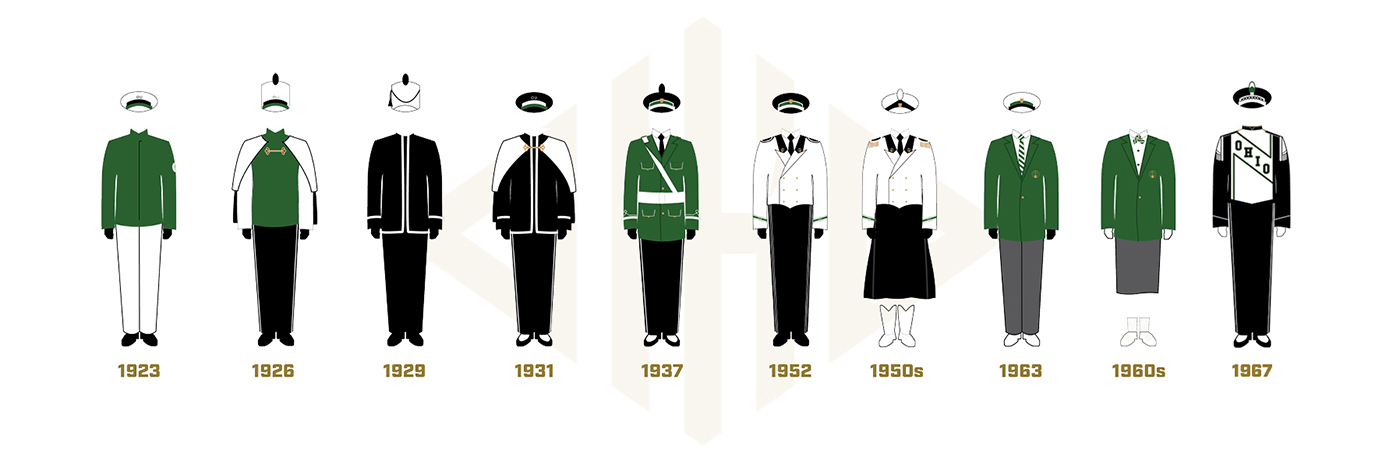
After early, rapid-fire changes, the marching band began to find its style. The “Ivy League” look of the early 1960s was requested by then-President John Calhoun Baker. In 1967, director Gene Thrailkill conceptualized the uniform style still used today. Infographic by Abbey Phillips, BSVC ’19
That era would birth nearly all of the band’s traditions, from its dances to its instrumentation. Fowler helped craft some of those first dances, including a 1968 routine to “Ain’t Been Good” that is still performed after home football games today. As for the instrumentation: No men were interested in playing flute or piccolo in the late 1960s, so the band instead performed with clarinets, saxophones, brass and drums.
“The dancers just absolutely took people by storm,” says former mellophone player Tom McKee, BSJ ’73. He recalls performing Frankie Valli’s “Can’t Take My Eyes Off You” with a basic dance step that still turned heads.
“We took that show to Miami, and we got a standing ovation from the Miami crowd … I have never heard such a loud ovation in my life,” McKee says. Shortly after, Thrailkill got a letter from Miami University’s president, McKee recalls, saying “something along the lines of ‘I’m never going to be embarrassed like that again.’”
The Marching Men of Ohio lasted eight years. In 1975, Director Ronald P. Socciarelli readmitted women to the marching band in the wake of Title IX. With the addition of women, the name changed from the 110 Marching Men of Ohio to the Marching 110.
No longer referring to the size of the band, its namesake 110 took on new meaning, referring to the 110% effort given by each member at each performance. The following year, the 110 became the first marching band ever to perform at Carnegie Hall.
Peden Stadium isn’t the only campus venue for the Marching 110’s performances. Here, the band welcomes incoming freshmen during the 2022 Student Involvement Fair on College Green. Photo by Rich-Joseph Facun, BSVC ’01

The Jacket
Perhaps nothing sets apart a marching band member on Athens’ campus quite like the green jacket with the white patch of Ohio. Students practically live in them. Alumni try to fit back into them. They unite band members across directors and decades.
“It’s something that is internal to us, because it’s like a symbol of membership,” says Boyer, the former field commander and assistant director. “But it’s external in that everybody sees that jacket and understands [the wearer is] a member of the Ohio University Marching Band.”
The jacket is a symbol and a reminder that each band member is a part of something bigger than themselves on campus. “It was just an absolute thing of pride to put that jacket on,” McKee says.
Two years ago, band members started a new tradition of presenting the green jackets during a formal ceremony that includes the reading of a poem written by McKee.
“Everyone wants to have one, because when you see the band jacket, everyone else knows you’re affiliated with one of the greatest organizations on campus,” says Eric Steere, a senior trumpet player who will lead the marching band as its field commander in 2023.
“The community of OHIO is something you won’t get anywhere else.”
As field commander, Steere oversees marching technique and morale, though he does not conduct the band the way a traditional drum major would.
Steere first learned of his new role during lunch with his brother, Ryan Steere, BS ’21, who served as field commander in 2020. Suk and Boyer unexpectedly joined them. Partway through the meal, Suk asked Ryan if he had something to give his younger brother.
Ryan pulled a field commander whistle out of his pocket.
“In that moment, I was speechless,” Eric says. “I can’t even put into words how amazing that moment was for me.”
@officialohiouniversity Ever wondered what it’s like being a member of the @ohiomarching110 on game day? Check out a day in the life of Ryan Bunyard, a sophomore studying music education who is a part of the Marching 110 Drumline. 🥁😸 #OhioUniversity #ForeverOHIO #Marching #MarchingBand #MarchingSeason #MarchingBandSeason #Marching110 #OhioUniversityMarching110 ♬ original sound - Ohio University 😸

The Present
The current Marching 110 shares the same steps and swagger of its predecessors. Its members still strive to be “better than the best ever,” a motto coined by Socciarelli.
“It is the most important, influential organization on the campus,” says Dr. William Talley, director of bands at Ohio University.
A typical week for the 110 includes practice from 5:30 to 7 p.m. Monday through Friday and an extra practice that begins at 9 p.m. Thursday nights. The marching band learns a new show for every home game, which includes marching formations, several songs and a dance routine to the drum break.
“It’s the 110 magic where, as stressed as you are about a show, we always pull through,” says Steere.
Suk, along with his assistant director, graduate assistants and students like Steere, selects the songs the band will play before the season begins. They pick current hits, homages to the past and themed shows.
This fall, Steere and his fellow 110 members will take the field at Peden Stadium wearing the same style of black, white and green uniforms, OHIO emblazoned diagonally across the front. They’ll march the same steps. They’ll thrill the crowd with flashy dances and top hits—the same formula the 110 has used since 1967.
It’s about a 100-year history. It’s about tradition. But it’s also about those musicians on the field, giving their all to be better than the best ever.
Featured image caption: Ohio University’s marching band, circa 1925. Founder Home Baird, GEN ’26, is pictured in the front row, second from the right (behind the drums). Photo courtesy of the Mahn Center for Archives & Special Collections


